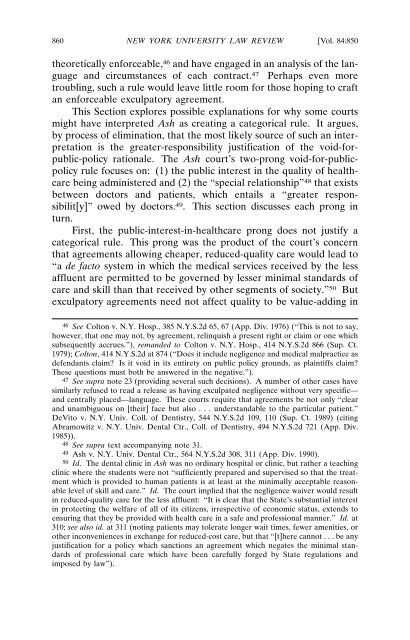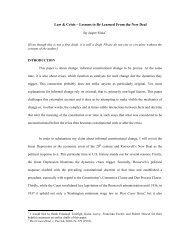In Search of an Enforceable Medical Malpractice Exculpatory
In Search of an Enforceable Medical Malpractice Exculpatory
In Search of an Enforceable Medical Malpractice Exculpatory
You also want an ePaper? Increase the reach of your titles
YUMPU automatically turns print PDFs into web optimized ePapers that Google loves.
860 NEW YORK UNIVERSITY LAW REVIEW [Vol. 84:850<br />
theoretically enforceable, 46 <strong>an</strong>d have engaged in <strong>an</strong> <strong>an</strong>alysis <strong>of</strong> the l<strong>an</strong>guage<br />
<strong>an</strong>d circumst<strong>an</strong>ces <strong>of</strong> each contract. 47 Perhaps even more<br />
troubling, such a rule would leave little room for those hoping to craft<br />
<strong>an</strong> enforceable exculpatory agreement.<br />
This Section explores possible expl<strong>an</strong>ations for why some courts<br />
might have interpreted Ash as creating a categorical rule. It argues,<br />
by process <strong>of</strong> elimination, that the most likely source <strong>of</strong> such <strong>an</strong> interpretation<br />
is the greater-responsibility justification <strong>of</strong> the void-forpublic-policy<br />
rationale. The Ash court’s two-prong void-for-publicpolicy<br />
rule focuses on: (1) the public interest in the quality <strong>of</strong> healthcare<br />
being administered <strong>an</strong>d (2) the “special relationship” 48 that exists<br />
between doctors <strong>an</strong>d patients, which entails a “greater responsibilit[y]”<br />
owed by doctors. 49 . This section discusses each prong in<br />
turn.<br />
First, the public-interest-in-healthcare prong does not justify a<br />
categorical rule. This prong was the product <strong>of</strong> the court’s concern<br />
that agreements allowing cheaper, reduced-quality care would lead to<br />
“a de facto system in which the medical services received by the less<br />
affluent are permitted to be governed by lesser minimal st<strong>an</strong>dards <strong>of</strong><br />
care <strong>an</strong>d skill th<strong>an</strong> that received by other segments <strong>of</strong> society.” 50 But<br />
exculpatory agreements need not affect quality to be value-adding in<br />
46 See Colton v. N.Y. Hosp., 385 N.Y.S.2d 65, 67 (App. Div. 1976) (“This is not to say,<br />
however, that one may not, by agreement, relinquish a present right or claim or one which<br />
subsequently accrues.”), rem<strong>an</strong>ded to Colton v. N.Y. Hosp., 414 N.Y.S.2d 866 (Sup. Ct.<br />
1979); Colton, 414 N.Y.S.2d at 874 (“Does it include negligence <strong>an</strong>d medical malpractice as<br />
defend<strong>an</strong>ts claim? Is it void in its entirety on public policy grounds, as plaintiffs claim?<br />
These questions must both be <strong>an</strong>swered in the negative.”).<br />
47 See supra note 23 (providing several such decisions). A number <strong>of</strong> other cases have<br />
similarly refused to read a release as having exculpated negligence without very specific—<br />
<strong>an</strong>d centrally placed—l<strong>an</strong>guage. These courts require that agreements be not only “clear<br />
<strong>an</strong>d unambiguous on [their] face but also . . . underst<strong>an</strong>dable to the particular patient.”<br />
DeVito v. N.Y. Univ. Coll. <strong>of</strong> Dentistry, 544 N.Y.S.2d 109, 110 (Sup. Ct. 1989) (citing<br />
Abramowitz v. N.Y. Univ. Dental Ctr., Coll. <strong>of</strong> Dentistry, 494 N.Y.S.2d 721 (App. Div.<br />
1985)).<br />
48 See supra text accomp<strong>an</strong>ying note 31.<br />
49 Ash v. N.Y. Univ. Dental Ctr., 564 N.Y.S.2d 308, 311 (App. Div. 1990).<br />
50 Id. The dental clinic in Ash was no ordinary hospital or clinic, but rather a teaching<br />
clinic where the students were not “sufficiently prepared <strong>an</strong>d supervised so that the treatment<br />
which is provided to hum<strong>an</strong> patients is at least at the minimally acceptable reasonable<br />
level <strong>of</strong> skill <strong>an</strong>d care.” Id. The court implied that the negligence waiver would result<br />
in reduced-quality care for the less affluent: “It is clear that the State’s subst<strong>an</strong>tial interest<br />
in protecting the welfare <strong>of</strong> all <strong>of</strong> its citizens, irrespective <strong>of</strong> economic status, extends to<br />
ensuring that they be provided with health care in a safe <strong>an</strong>d pr<strong>of</strong>essional m<strong>an</strong>ner.” Id. at<br />
310; see also id. at 311 (noting patients may tolerate longer wait times, fewer amenities, or<br />
other inconveniences in exch<strong>an</strong>ge for reduced-cost care, but that “[t]here c<strong>an</strong>not . . . be <strong>an</strong>y<br />
justification for a policy which s<strong>an</strong>ctions <strong>an</strong> agreement which negates the minimal st<strong>an</strong>dards<br />
<strong>of</strong> pr<strong>of</strong>essional care which have been carefully forged by State regulations <strong>an</strong>d<br />
imposed by law”).
















